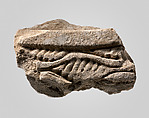Relief fragment
Not on view
The first Ctesiphon expedition, sponsored by the Deutsche Orient-Gesellschaft in 1928-1929, uncovered numerous stuccos ranging from the Sasanian period through the early Islamic period. In the area of Selman Pak, early Islamic houses were discovered. The stucco decorations show a continuity with the earlier Sasanian styles, with depictions of foliage and repeating patterns. This fragment of a vine and leaf pattern would likely have formed part of a border of a larger design.
The city of Ctesiphon was located on the east bank of the Tigris River, 20 miles (32 km) south of modern Baghdad in Iraq. It flourished for more than 800 years as the capital of the Parthians and the Sasanians, the last two dynasties to rule the ancient Near East before the Islamic conquest in the seventh century. Systematic excavations in the Ctesiphon area were undertaken by an expedition in 1928–29 sponsored by the German Oriental Society (Deutsche Orient-Gesellschaft). The Metropolitan Museum of Art and the Staatliche Museen, Berlin, undertook a joint expedition for one season in 1931–32. Several excavations were conducted, including at the main palace (Taq-i Kisra), in a small fortified area south of the palace at Tell Dheheb, at multiple houses at the mounds of Ma’aridh, and at additional houses at a small mound called Umm ez-Za’tir.
After the Muslim conquest of Ctesiphon in 637, a new settlement was established in the area of the modern village of Selman Pak and new houses continued to be built into the 10th century. During the Ctesiphon Expedition several richly decorated Arab houses were excavated. Some of the decorative elements show the continued influence of Sasanian styles.
Due to rights restrictions, this image cannot be enlarged, viewed at full screen, or downloaded.

